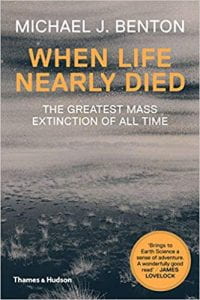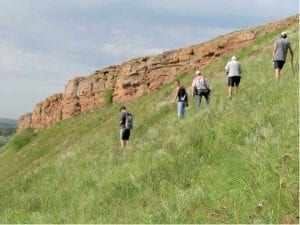 The Permo-Triassic mass extinction is important for two reasons:
The Permo-Triassic mass extinction is important for two reasons:
- it was the greatest mass extinction of all time, killing perhaps 90% of all species on Earth; and
- it reset the evolution of life on land and in the sea, launching a massive recovery of life that underpins much of modern biodiversity.
Read all about it in ‘When Life Nearly Died’ (Michael Benton, Thames & Hudson 2015). Order here.
 The Permo-Triassic mass extinction (PTME) was a key event in the history of the Earth, marking a major overturn of ecosystems. In the Permian, seas were dominated by ‘Palaeozoic groups’ such as rugose and tabulate corals, trilobites, brachiopods, and crinoids, and the land by glossopterids and synapsids. All of these disappeared during the crisis. After the event, in the Triassic, ‘modern’ groups diversified, such as bivalves, gastropods, echinoids, and bony fishes in the seas, and dinosaurs, lizards, turtles, frogs, and mammals on land.
The Permo-Triassic mass extinction (PTME) was a key event in the history of the Earth, marking a major overturn of ecosystems. In the Permian, seas were dominated by ‘Palaeozoic groups’ such as rugose and tabulate corals, trilobites, brachiopods, and crinoids, and the land by glossopterids and synapsids. All of these disappeared during the crisis. After the event, in the Triassic, ‘modern’ groups diversified, such as bivalves, gastropods, echinoids, and bony fishes in the seas, and dinosaurs, lizards, turtles, frogs, and mammals on land.
Understanding of the timing, causes, and effects of the mass extinction is important. Was it an asteroid impact, massive volcanic eruptions, or some other cause? The PTME marks the time when life came closest to complete annihilation, so it is worth knowing why. Further, if some of the causes of the extinction include global warming, acid rain, ocean stagnation, and ocean acidification, understanding these crises may inform our understanding of present and future global environmental change on the Earth. The experiments have already been run!

New work in China, Russia and other parts of the world has massively improved our understanding of what happened. Improvements in rock dating have helped to focus the timing of the event, and studies of rock successions show how climates were affected. In particular, studies of terrestrial successions have shown how the land was stripped and washed away.
Understanding the recovery of life after such devastation is fascinating. This becomes a key test theme in macroevolution: if the roots of modern biodiversity track back to the Triassic, how did key clades such as bivalves, gastropods, crustaceans, neoselachians, teleosts, lepidosaurs, and mammals become established? Are the ‘rules’ for diversification after mass extinctions the same as during classic, novelty-led adaptive radiations? Phylogenetic approaches allow palaeobiologists to explore the interplay of biodiversity, morphology, and function in this critical episode in the history of life.

